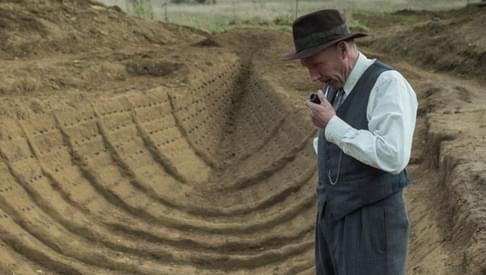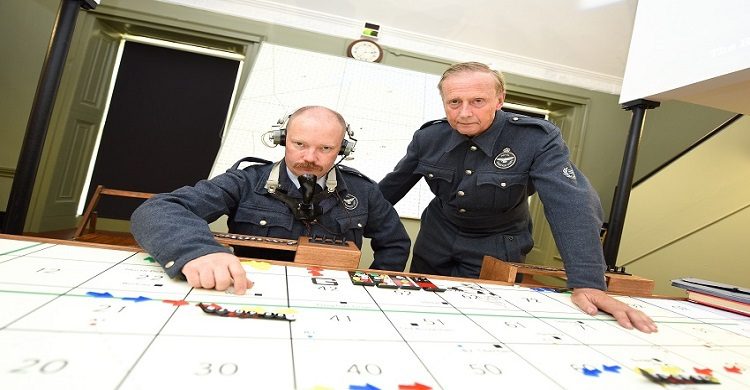
Back to Blogs
Discover
New Film Tells the Story of Basil Brown & Sutton Hoo
'The Dig' stars Ralph Fiennes as Suffolk archaeologist Basil Brown who discovered Sutton Hoo!
Did you know Basil Brown also confirmed there was an Anglo Saxon Village in West Stow near Bury St Edmunds?
Netflix film The Dig tells the true story of the 1939 excavation of Sutton Hoo near Woodbridge in Suffolk, where one of the most important archaeological discoveries of all time - an Anglo-Saxon burial ship full of treasures was found.
For centuries it was unknown what lay under a burial mound until Edith Pretty, owner of the Sutton Hoo land, employed the self-taught Suffolk archaeologist Basil Brown, who lived in Rickinghall, to excavate the site. A British Museum-led team joined the dig after its huge significance was established and Mrs Pretty later donated the treasure found at Sutton Hoo to the British Museum.

Courtesy of the National Trust
The burial ship found at Sutton Hoo, now owned by the National Trust, is believed to be the final resting place of East Anglian king Rædwald, who ruled over Norfolk and Suffolk from about 599 until 624. The iconic helmet and some treasures believed to have belonged to him are on display at the British Museum. It is no wonder Sutton Hoo is often referred to as 'England's Valley of the Kings'.
There are around eighteen burial mounds within the Royal Burial Ground at Sutton Hoo. Many have been so eroded over the centuries that it is hard to know exactly how many there were. The burials date to the seventh-century AD. The people buried here left no written records, so it is impossible to know exactly who they were, but historians strongly suspect that Sutton Hoo was the cemetery for the royal dynasty of East Anglia, the Wuffingas, who claimed descent from the god Woden.
Sutton Hoo
Basil Brown and West Stow

Photo copyright Suffolk County Council used by kind permission.
As well as Sutton Hoo, Basil Brown also confirmed the existence of an early Anglo-Saxon village in West Stow, near Bury St Edmunds, occupied from AD 420-650, over 400 years before the Norman Conquest.
In 1947, Basil Brown ran an excavation at West Stow which unearthed two Romano-British pottery kilns. During the excavation, it became clear that there had also been an Anglo-Saxon settlement on the site.
On the excavation was Stanley West, who had first become interested in Anglo-Saxon England when working as an assistant at the Ipswich Museum where met Basil Brown just eight years after he had excavated Sutton Hoo.
West went on to lead the main excavation at West Stow from 1965-72 and his experimental work reconstructing Anglo Saxon buildings ultimately gave birth to the visitor attraction West Stow Anglo Saxon Village, just 15 minutes from Bury St Edmunds.
Stanley credits Basil Brown’s ‘boundless enthusiasm’ as influencing his archaeological interests and career and when Basil Brown’s wife died in 1984 Stanley collected all of Brown’s written material. Much of this is held by the Suffolk County Council’s Suffolk Archaeological Service, with his notebooks on Sutton Hoo being passed to the British Museum.
Basil (pictured below) finished up working as caretaker at Culford School, near Bury St Edmunds, where he encouraged pupils to take an interest in archaeology.

Photo copyright Suffolk County Council used by kind permission.
Today, visitors can see the reconstructed West Stow Anglo Saxon Village comprising eight buildings including a craft building, farmers house, weaving house, and a workshop. The site is surrounded by 125 acres of unspoilt countryside.
The West Stow Anglo-Saxon Museum and Gallery features an exhibition of objects and artefacts found at West Stow. The Anglo-Saxon people who lived on this settlement are represented through a variety of displays which tell the story of how they lived and worked using the jewellery they wore, the tools and weapons they used and the items they were buried with.
There is also the chance to dress like an Anglo-Saxon and wear the helmet of a warrior with interactive exhibits. The story of the site unfolds as you walk the galleries, bringing to life the people of the village settlement which existed 1,500 years ago.
West Stow Anglo Saxon Village
The Dig, based on the novel 'The Dig' written by John Preston, stars Ralph Fiennes as Basil Brown, Carey Mulligan as Edith Pretty, and Lily James as archaeology student Peggy Preston.
Fiennes, who was born and raised in Suffolk until he was six, was determined to nail down a true Suffolk accent so contacted Screen Suffolk to help find not only an assistant but crucially someone who also had an ear for the true Suffolk dialect. Film maker and musician Jay Ducker saw the shout out on Facebook and he got the job. Jay’s first day was at Snape Maltings where the crew were filming their first landscape scenes of the famous Suffolk sky, reeds and beaches. The crew filmed in and around Suffolk for a week.
Further Information
Suffolk County Council Archaeological Service website has a series of blog posts exploring Basil’s life beyond Sutton Hoo.
For more on the story of The Dig and the real life 'stars' of the story visit The National Trust Sutton Hoo's website.
For more information visit the West Stow Anglo Saxon Village website.
The Dig is available on Netflix.
Trailer for The Dig
Related Events

Related Blogs

News
Bury Tour Guides to launch…
Bury St Edmunds Tour Guides to Introduce new tours in…

News
Town’s Museum Forms New…
Moyse’s Hall Museum will be forging links with a…

News
St Edmundsbury Cathedral…
St Edmundsbury Cathedral in Bury St Edmunds is…

News
Bury St Edmunds & Beyond…
Step inside many of Bury St Edmunds historic buildings…

News
Bury's Best Pubs with a Past
some notable, historic and somewhat quirky pubs and…
Latest news

News
How to Spend Betwixtmas in Bury St Edmunds & Beyond
The post Christmas period is the perfect time to get out and about before the new year kicks in, and you’ll find plenty of activities and places to visit in Bury St Edmunds and beyond.

News
Parents Guide to Pre Christmas Entertainment
It's the school holidays and with Christmas just around the corner we've put toegther a guide on places to take the kids to keep them entertained until Santa visits!

News
Enjoy a Festive Afternoon Tea in 2025
Celebrate the Christmas season with a festive afternoon tea in Bury St Edmunds & Beyond...

News
Festive Winter Walks
Get outside and enjoy the fresh crisp winter air with one of these walks in Bury St Edmunds and Beyond!

News
Bury Tour Guides to launch new tours next year after successful 2025
Bury St Edmunds Tour Guides to Introduce new tours in 2026 and continue the successful Food and Drink Tours!

News
New in Bury St Edmunds For 2026
A sneak peak into new attractions visitors can enjoy in Bury St Edmunds in 2026.

News
Baby It's Cold Outside... Things To Do When the Weather Turns Frosty
Just because the temperature’s dropped doesn’t mean the fun has to! If you’re visiting town during the chillier months, there’s still plenty to see, do, and experience.

News
Places to sit by a roaring fire in Bury St Edmunds & Beyond
Warm up by a roaring fire this winter in Bury St Edmunds & Beyond...

News
Christmas Park and Walk 2025
Additional parking has been provided by West Suffolk Council in partnership with Greene King this Christmas.
